News
Conserving The Statutes at Large volumes from the Law Library Rare Book Room
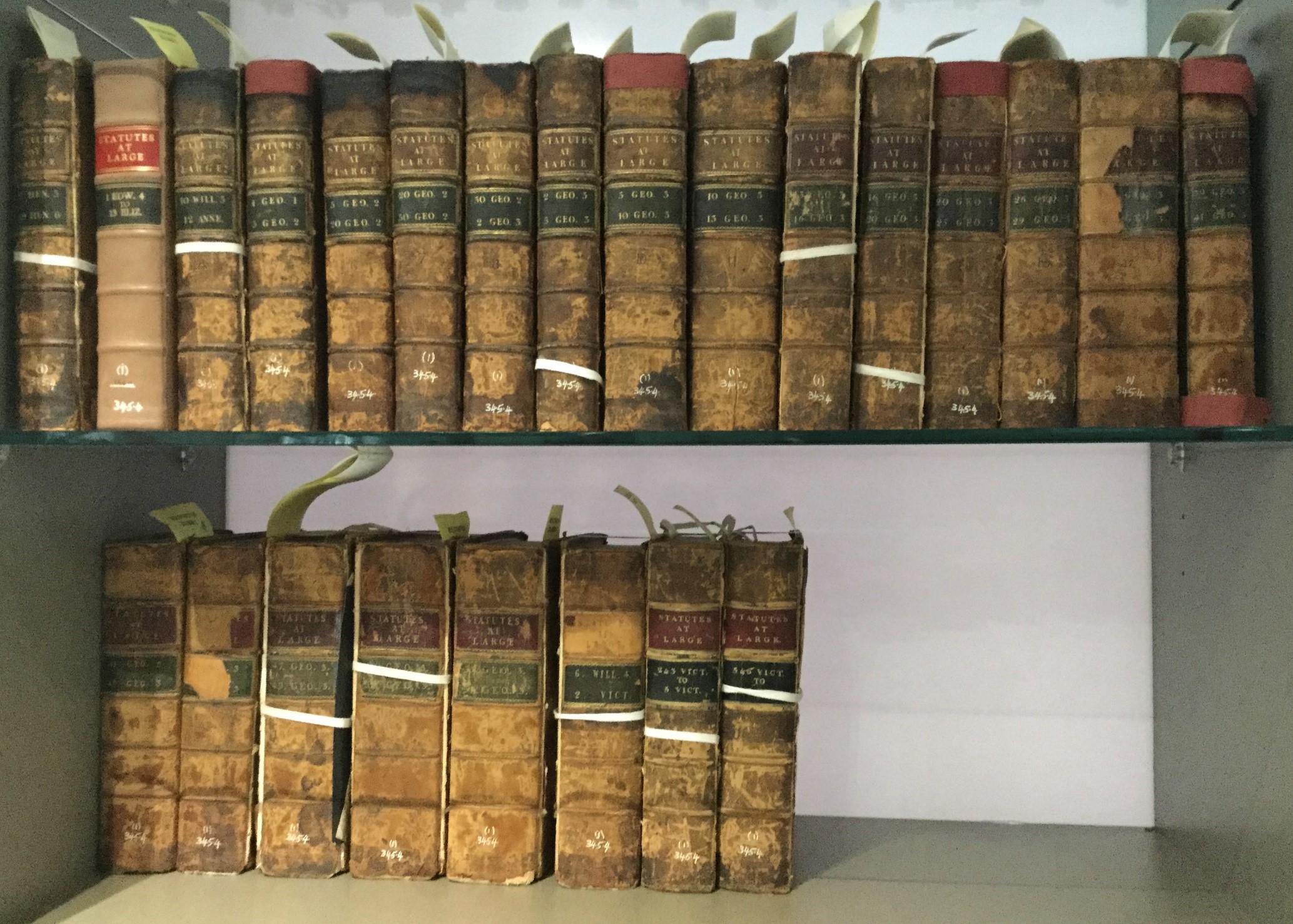
Conservators are often engaged by collection caretakers to conduct surveys of their collection in order to assess the condition of items and provide recommendations for their continued care. In 2017, Grimwade Centre conservators were tasked with one such project and carried out a survey on the Statutes at Large volumes from the University of Melbourne’s Law Library Rare Book collection. Twenty-four volumes belonging to Sir Redmond Barry were identified and recommended for further conservation treatment. Miegunyah Bequest funding was awarded for the project, principally to stabilise the volumes for digitisation, allowing the contents of the volumes to become more accessible to current researchers and future generations.
Initial Cleaning

In the first stage of the project, each of the twenty-four volumes were cleaned using a combination of techniques. Loose dirt was removed from the covers and edges of the text-blocks using soft brushes and micro-fibre cloths. Brush cleaning was undertaken on every page, including in the gutters of the book, and more heavily soiled areas were cleaned using vulcanised rubber sponges. Any additional materials found in the volumes during cleaning, such as inscribed bookmarks, were bagged and labelled with their original locations.
The cleaning process had the added benefit of allowing conservators to conduct a detailed examination of the volumes, identifying areas where further treatment was required. These other treatments include separating adhered pages, mending tears, flattening folds, and reattaching loose covers.
Separating Pages
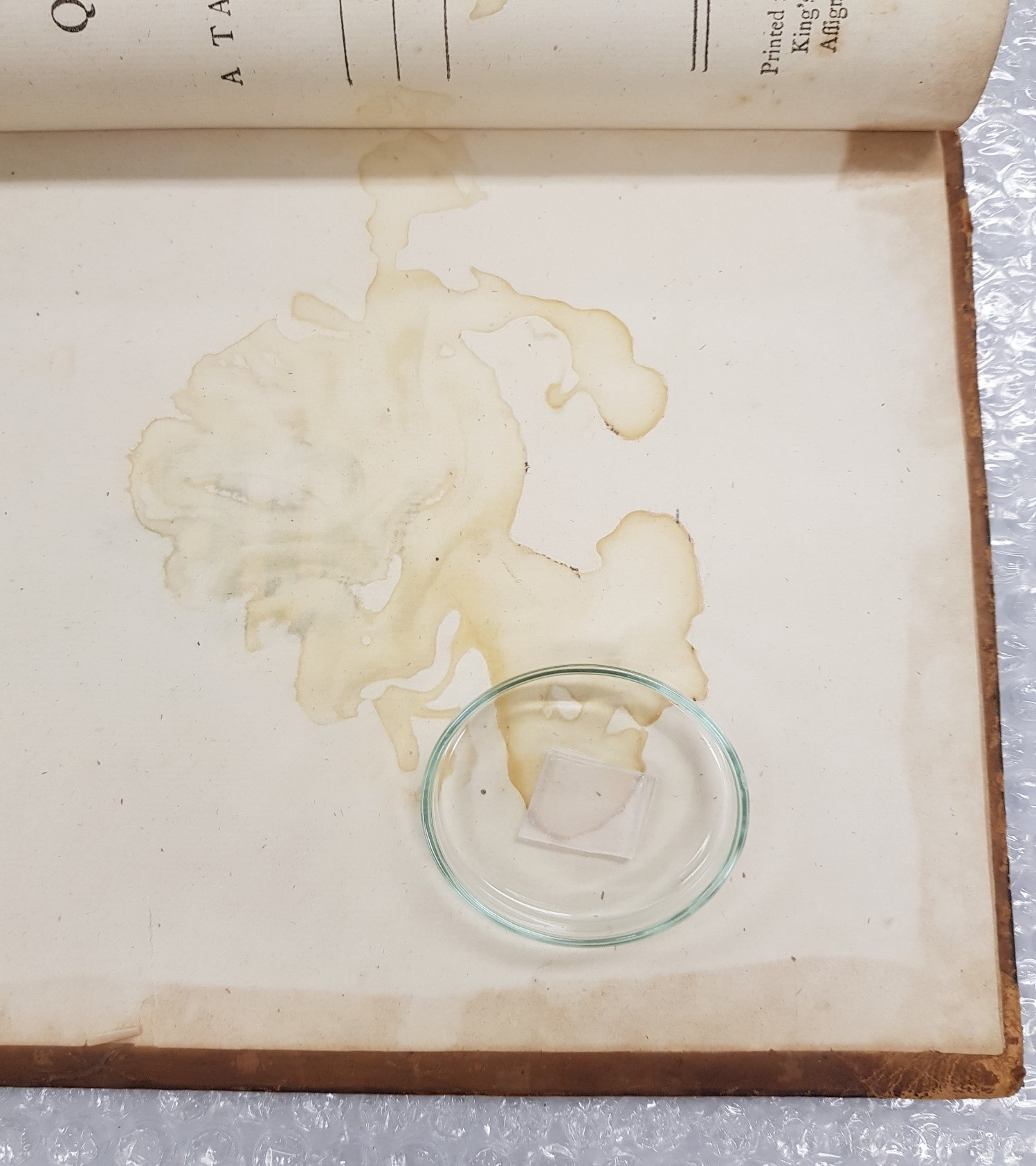
One of the volumes examined contained pages that had been adhered together by an unidentified substance. This resulted in inscriptions by Sir Redmond Barry being obscured. Separating these pages proved to be a tricky task for the conservators, as the substance did not respond to the various poultices and enzymes often utilised for this type of treatment. In the end, the conservators were forced to manually separate the pages using scalpels, with the aid of magnification.
Occasionally during a book's manufacture, when the text-block is cut, some pages are missed by the blade of the guillotine and therefore remained joined at the edge and cannot be opened for viewing. This was the case with a few pages in one of the volumes and this situation was rectified by cutting the join with a knife, thus allowing the pages to be read.
Repairing Torn Pages

Tears and losses to the pages in the volumes were mended using Japanese conservation papers applied with wheat starch paste. Conservators use these materials for mending paper items due to both the compatibility and reversibility of the materials. The type of Japanese paper chosen for repair were tailored according to the weight and colour of the pages.
Applying a minimal amount of moisture along fold lines and creases, allowed these areas to relax and they were able to be ironed flat using small heated spatulas.
The number of volumes, and their collective condition made this a time-consuming exercise. Conservators also carried out additional work during this stage such as removing adhesive tape and re-attaching original labels.
Reattaching Covers
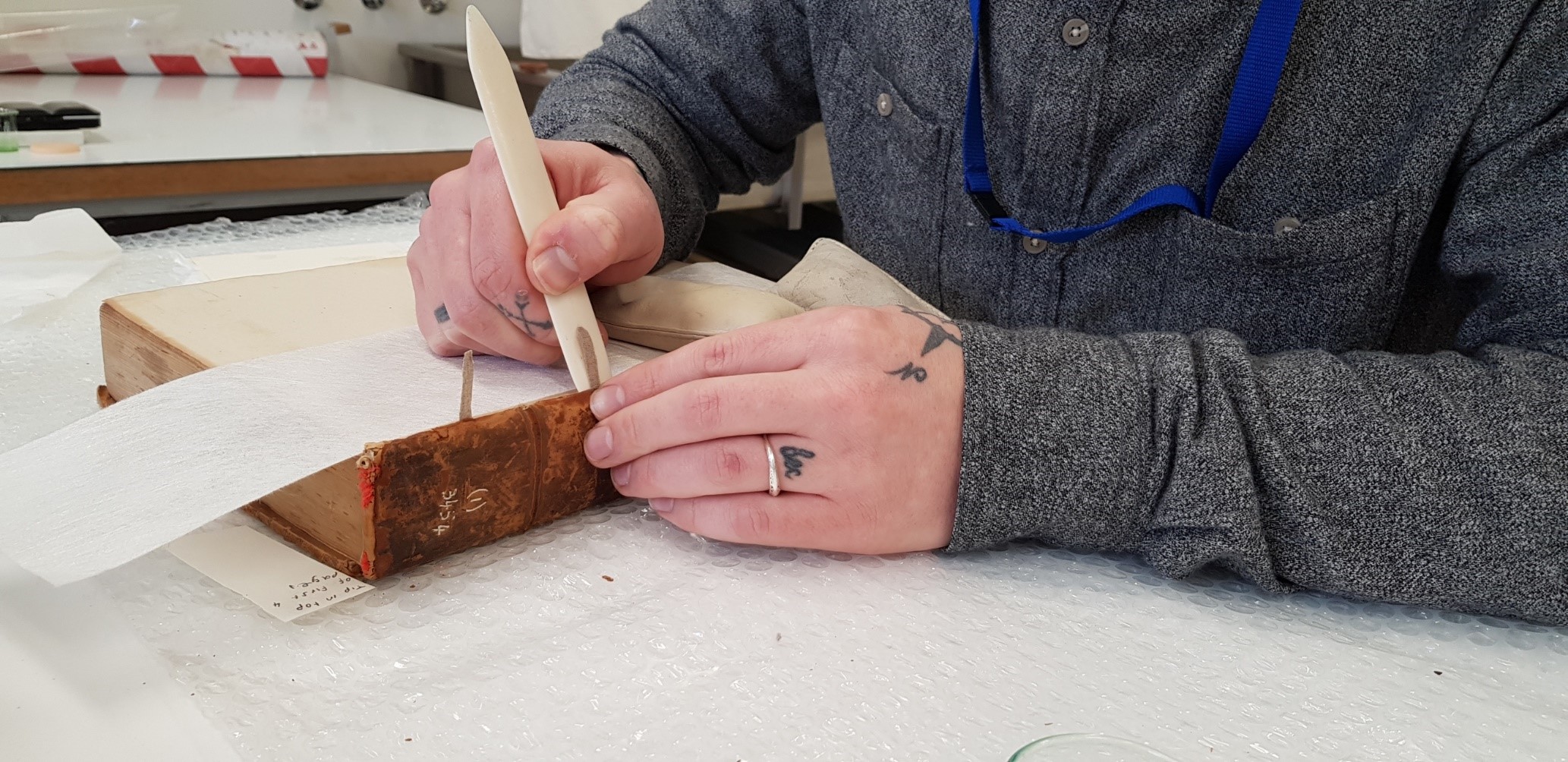
The detached covers on several volumes were reattached using suture repairs. In these areas the leather was lifted and small strips of aero-linen were inserted at strategic points along the spine, then adhered in place.
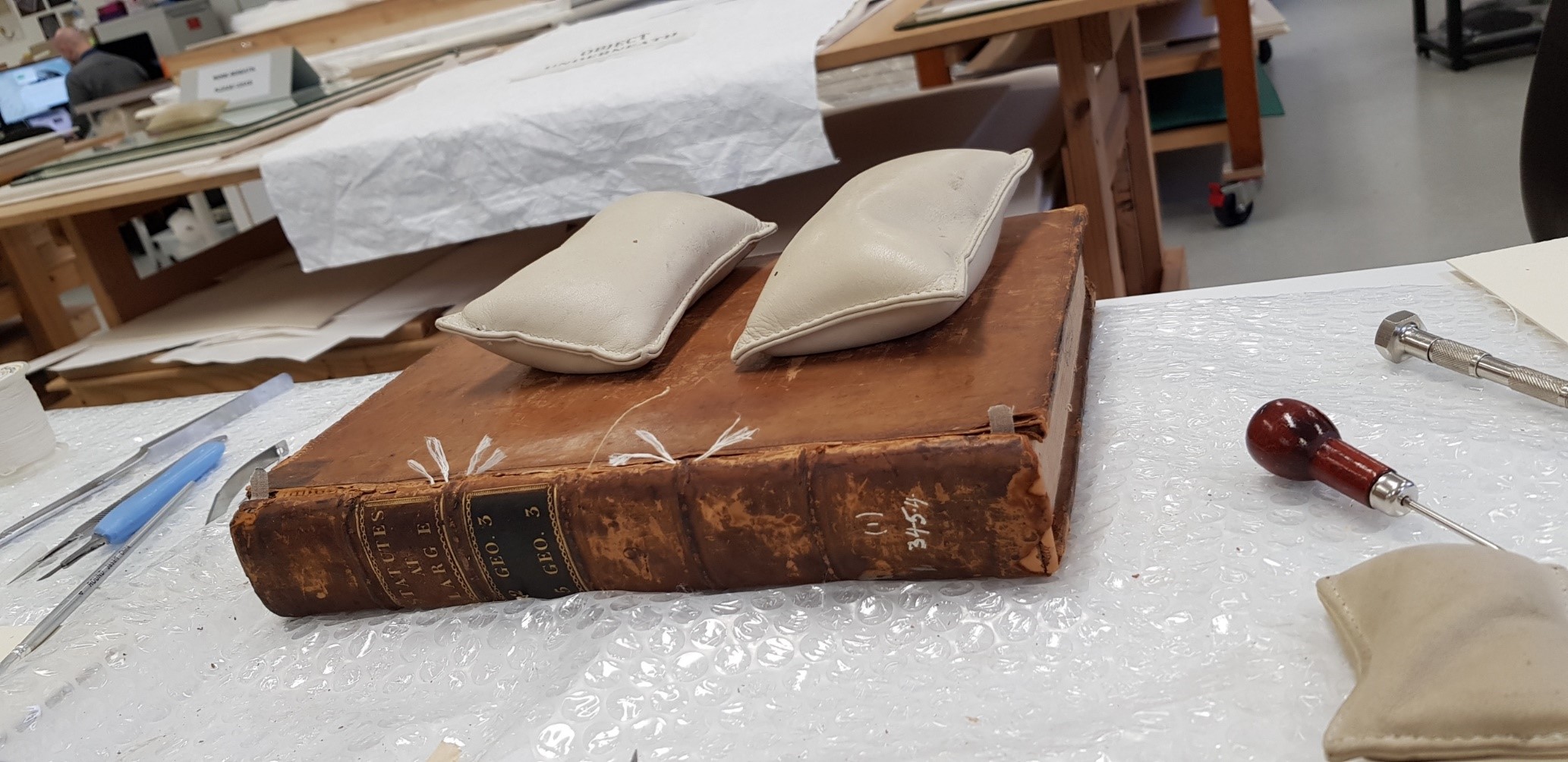
Where sutures were not able to be safely inserted, original cords were extended by sewing linen thread through the ends of the cords. These threads were then feathered and flattened out and inserted beneath the leather covering the boards in the same fashion as the aero-linen sutures. Finally, toned Japanese paper was adhered along the joints to provide extra strength.
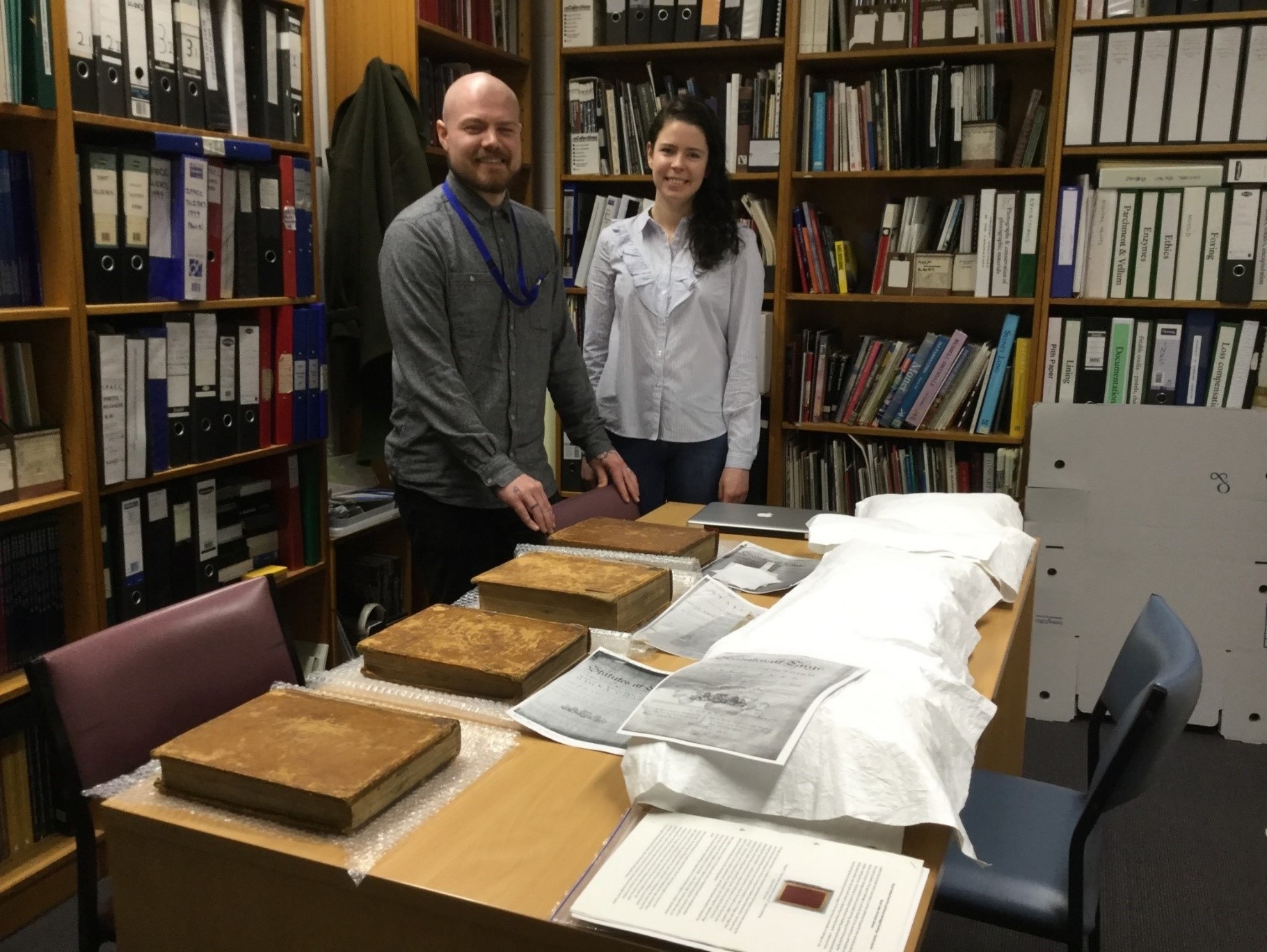
The project took several months to complete and provided an excellent opportunity for two emerging conservators to further develop their skill sets. As a result of their hard work, the volumes have been successfully stabilised and are now ready to be accessed by the University of Melbourne’s digitisation team.
Conservation in Regional Australian Collections

Senior Paintings Conservator, Cushla Hill has just returned from outback NSW where she attended the unveiling of Broken Hill Regional Art Gallery's Nineteenth Century key painting "Vae Victis". Broken Hill Regional Art Gallery (BHRAG) is the oldest regional gallery in NSW established in 1904. This large work was donated to BHRAG in its first decade of existence, by the widow of Mr George McCulloch, who was a founding member of Broken Hill Proprietary limited (BHP).
This event followed the 9 month Conservation project undertaken by Grimwade staff at the North Melbourne laboratory.

The project involved collaboration with specialist packing and transport personnel from International Art Services (IAS) to relocate the work to Melbourne, BHRAG staff directed by Tara Callaghan, Technical examination and analysis by Cushla Hill and Vanessa Kowalski, and the Conservation treatment of the painting and frame by Cushla Hill and Jordi Casasayas.
Cushla presented her research findings at an unveiling event at Broken Hill, attended by 80 donors and Gallery friends. During the visit she surveyed the collection on display at BHRAG and in storage, with some planning for future Conservation projects. The hospitality and environment of this fascinating historical mining town was a wonderful experience.
Please take a look at the videos below c/-BHRAG:
Melbourne Metro Tunnel Archaeological Investigation
The objects team are undertaking archaeological conservation 'first aid' on finds excavated by Ochreimprints on the Metro Tunnel archaeological investigation in the CBD of Melbourne. Objects found reflect the period of site use from teeth with dental decay dating to when the site was a dental surgery to gaming pieces, bottles and bottle openers from the period that it was a pub. The conservation team assess artefacts to see if immediate stabilisation is required and undertake cleaning and stabilisation. Damp organic finds are placed bagged in a fridge to assist in preventing cracking. The major rule with organic archaeological finds found on excavations is if it is damp keep it damp, if its wet keep it wet and when its dry keep it dry.'
Watch a 7News video of the project.
Magna Carta - Parliament of Australia
The Magna Carta is one of Australia's top treasures. Part of the Parliament of Australia's collection, the edition dates from 1297, is one of only four in existence, and the only copy in the Southern Hemisphere. From 2016-2017, conservators from the Grimwade Centre undertook conservation treatment of the Magna Carta and scientific research of the materials used for its construction, including identification of the parchment type, the ink used for the script, the type of fibre and dye used for the braided tassle, as well as detailed photographic examination of the wax seal to highlight the figure. Parliament of Australia has documented the project extensively.
For more information detailing the Grimwade Centre's involvement, read more about the Magna Carta and watch some of the video footage.
Conservation of the Blaeu Map - Archipelagus Orientalis
Throughout 2017, the paper conservation team undertook a major conservation project of the unique Archipelagus Orientalis (Eastern Archipelago), from the National Library of Australia collection. One of only four maps in existence, it is considered an important map of the Dutch East India Company, highlighting Dutch sea power in South East Asia. The map, created in the seventeenth century, is the earliest large-scale map of the Dutch discoveries of the region and has all the mapping up to and including Tasman. The conservation team stabilised the fragile artefact, removed the degraded varnish across the surface and undertook selective reintegration of areas of loss. Some analysis of the materials was also undertaken, giving conservators and historians an insight into the materials used in the construction and painted detail of the map.
To read more about the project please see The Blaeu Map Returns web page.
The conservation treatment of Broken Hill's treasure
In 2017, Senior Paintings Conservator, Cushla Hill undertook conservation treatment and analysis of Broken Hill Regional Art Gallery's most valuable painting, Vae Victis, the sack of Morocco by the Almohades by Arthur Hacker.
To read more about the conservation treatment, analysis and history of the painting, please see the ABC The dark history behind Broken Hill's most valuable painting web page.
Trades Hall - history revealed
A team of conservators and conservation students from the Grimwade Centre have worked to reveal a small piece of history in Victoria's Trades Hall building.
Read more about the Trades Hall project
Rebuilding cultural heritage after disaster
After an earthquake devastated the Philippines in 2013, the Grimwade Centre conservators went beyond conventional cultural conservation practices and involved the local community in the restoration of their churches. Dr Nicole Tse lead the team of conservators in the field.
To find out more about the project please see the Rebuilding Cultural Heritage after Disaster web page.
Preservation workshop at Launceston Mechanics' Institute
Read about the preservation workshop delivered to the Launceston Mechanics' Institute by Grimwade paper conservator, Noni Zachri.
Materials analysis of Flinders Street Station paint samples
The Victorian Government has launched the redevelopment of Flinders Street Station. As part of the redevelopment, investigation into the original colour scheme of the historical building was undertaken by Conservators at the Grimwade Centre.
For more information about the project and to find out about the Grimwade Centre's involvement please see The Changing Colours of Flinders Street Station video.
Conservation treatment of the City of Caulfield Honour Roll
In 2015, with funds made available through the Victorian Government, conservation treatment was undertaken by conservators from The Grimwade Centre. As part of the treatment, the bronze and marble panels were vacuumed to remove dust and dirt. Losses in the marble were filled with plaster, then smoothed and painted to match the veins and colours within the existing marble.
For more information please see the City of Caulfield Honour Roll 1914-1919 web page.
Conservation treatment of the William Barak collection from Koorie Heritage Trust
Paintings by Wurundjeri leader William Barak, form a significant part of the Koori Heritage Trust. Dating between 1880s and 1890s, a painting from the collection was treated at the Grimwade Centre, and examination using infrared reflectography undertaken to assess the artist's technique.
For more information please see the Culture Victoria The William Barak collection at the Koorie Heritage Trust web page.
Bendigo Writers Festival 2016 - Caring for the Past
Historian and rural change researcher Liza Dale-Hallett talks with Bendigo Historical Society’s Kerry Conway and textile conservator Marion Parker about how best to preserve, display and explore the clothes and fabrics of our history - Friday August 12, 3-4pm.
Restoration of Hon. James Balfour Portrait from Ormond College Collection
In 2015, the Paintings Consrvation team restored a portrait of the Hon. James Balfour (1908) from the Ormond College art collection. Lesley den Hartog, Curator of Cultural Collections, has documented this project in the 'New + Old - Ormond College Magazine'. den Hartog comments that the portrait was painted by one of Australia's few early female artists, Josephine Muntz Adams, who was active as a painter from about 1896 to 1940. The project was part of the College's program to ensure the preservation of its heritage.
To read more about the project please see the N&O Dec 2015 web page (pg 22).
Launch of The Grimwade Centre for Cultural Materials Conservation
New research and teaching labs, with cutting edge analytical equipment for the analysis of cultural artefacts, opened in March 2015. The purpose-built facilities at the University of Melbourne, are the new home for staff and students of the Centre for Cultural Materials Conservation. "Grimwade Centre for Cultural Materials Conservation lifts street profile," June 1, 2017 on The Sydney Morning Herald website.
RSL Lifecare Museum at Narrabeen, NSW
Staff and students from The Grimwade Centre have undertaken extensive work on the collection at the RSL Lifecare Museum at Narrabeen, NSW. Under the project management of Sophie Lewincamp, the collection for display in the new museum has been prepared and installed for the opening prior to Anzac Day 2015. "Anzac 100: Piecing together the remnants of the past," April 24, 2015 on The Age website.
Conservation of Gallipoli Battlefield Objects, Canakkale Turkey
Holly Jones-Amin and Carmela Lonetti, objects conservators from The Grimwade Centre, travelled to Çanakkale, Turkey in 2014 to preserve objects uncovered in an historic tri-national interdisciplinary archaeological survey of the ANZAC battlefield. View full details of this project on the University of Melbourne's archived "Conserving the 100-year-old remnants of Gallipoli’s battlefields" VOICE web page.
'The Anzac Battlefield'
Opening of the exhibition, "The Anzac Battlefield" at the Shrine of Remembrance.
Gallipoli battlefield artefacts which were treated by The Grimwade Centre objects conservators, Holly Jones-Amin and Carmela Lonetti, in Turkey in 2014, are on display at the Shrine of Remembrance in Melbourne. The archaeological collection is supported by material from various University of Melbourne Cultural Collections. Material from the Print Collection at the Baillieu Library, the historical Map Collection and the University of Melbourne Archives were treated and prepared for exhibition by the paper conservation team led by Libby Melzer and including Briony Pemberton, Peter Mitchelson, Noni Zachri, Yvonne Hearn and Jordi Casasayas.
When Art Meets Science
The Grimwade Centre Director, Robyn Sloggett, discusses the role of conservation in art historical research. Watch a short video "When Art Meets Science" on the University of Melbourne's archived Visions website.
New Galleries of Remembrance
Jude Fraser, Manager, The Grimwade Centre, was as an invited guest on 11 November 2014 at the Remembrance Day Service and the Dedication of the Galleries of Remembrance at Melbourne's Shrine of Remembrance. The day also included a celebratory dinner with Shrine staff and other invited contractors who worked on the project - Pod, Fini Frames, lighting team, AV team, signage team.
The project commenced in May 2013 when The Grimwade Centre staff removed the 45 Colours (flags) hanging in the Crypt and the Changi Flag for cleaning, condition checking and packing. The Colours were reinstalled in late July 2014 after the finial heads on the pikes had been cleaned and 3 Colours underwent stabilisation treatment. The Changi flag (and the Battle of Britain lace from the RAAF Museum) was reinstalled in September 2014.
In May and July 2014 approximately 800 loan objects were assessed for required conservation work. Approximately 230 3D objects and 90 paper objects/photos were treated from mid June through to mid October 2014.
Some additional objects were also treated - some from the University of Melbourne Archives, 2 missiles from HMAS Cerberus, and numerous paintings and objects from the Australian War Memorial (pursuant to a separate contract with the AWM). Additional objects were also treated later for a temporary exhibition.
The project utilised the skills of most of the The Grimwade Centre team over the duration of the project. More Information:
ABC News - Shrine of Remembrance marks 80-year anniversary with gallery opening
Objects loaned to Melbourne's Hellenic Museum from the Benaki Museum in Athens
A team of five conservators from The Grimwade Centre have been working closely with the conservators from the Benaki Museum in Athens, Elefthereia Goufa and Naoum Kokkalas, during August and September 2014. They have been preparing condition reports for the travelling exhibition which is a standard procedure for museums. The condition of the valuable objects on loan to Melbourne's Hellenic Museum was recorded in written reports and annotated images prior to leaving the Benaki Museum. Upon unpacking the objects in Melbourne, the Benaki conservators and The Grimwade Centre conservators, working in pairs, examined each object and cross referenced to the written reports. Any changes or damages not previously noted, were recorded and the reports signed off by both parties. This process will be repeated at the end of the exhibition and again on return to the Benaki Museum. The purpose of the condition reports is to identify if and when any damages may have occurred, and to be able to determine why the damage may have occurred. This condition checking process is essential for insurance/indemnity purposes as well.
It was a great opportunity for The Grimwade Centre conservators to work with international colleagues and to see the objects up close and in detail, before the objects were secured behind glass in their showcases.
- View or Listen to Radio National's Report: Hellenic Museum hosts ancient Greek treasures
- View neoskosmos.com article: Guardians of the past
Made to Last: the conservation of art - Novemeber 2013 - February 2014
'Made to last: the conservation of art' is a NETS Victoria touring exhibition in partnership with The Grimwade Centre at the University of Melbourne and supported by Latrobe Regional Gallery. As part of the exhibition, five artists were interviewed; Brook Andrew, Penny Byrne, Juan Ford, Ghostpatrol and Claire Anna Watson, discussing their materials and techniques and their thoughts on the conservation of their work. (Camera: Josh McIvor. Equipment: Lemac.)
In conjunction with the exhibition, The Grimwade Centre staff have been presenting seminars and undertaking conservation appraisals for members of the public at each exhibition venue. On the opening day of the exhibition at Latrobe Regional Gallery in September 2012, conservators specialising in paintings, paper, books and photographic materials met with members of the public to assess and advise them on the condition of their objects and any conservation treatment requirements. Advice on storage, handling and display was also provided.
This was followed up with a similar session at the Art Gallery of Ballarat in Jan 2013 with support from some members the Victorian Division of the AICCM. In addition, Senior Paper Conservator, Libby Melzer presented a seminar on The Conservation of Paper and Paintings.
View the 'Made to Last: the conservation of art' interviews
Restoration of Girolamo Nerli's painting at the Catholic College of Sale
In late October, 2013, paintings conservators Cushla Hill and Vanessa Kowalski travelled to Sale, in Gippsland Victoria, to undertake the conservation treatment of a large painting by artist Girolamo Nerli.
The painted background was commissioned by the Sisters of Sion and painted in the early 20th century. The painted background is located in a niche, on the exterior wall of the chapel at the Catholic College of Sale, above the altar, and with the base located approximately 4 metres above floor level. The niche has a gothic arch at the front, with semicircular void to the glazed skylight above. The skylight permits illumination of painting and statue from above.
The painted background was executed on canvas by Girolamo Nerli, and according to records provided, was rolled for travel, and adhered behind the curved niche walls of the Chapel after being transported from Melbourne. The painted composition depicts pale blue sky and heavens, and middle-eastern landscape behind the Madonna. The background is located behind and above the plaster statue of Madonna and Child, which is raised on a stonework plinth in the niche.
The painting was in fair condition, having being subjected to water ingress and UV light from the skylight above the niche. The canvas was greatly deteriorated beneath the skylight, with mould damage, tears and holes. The paint layer had become detached from the canvas in areas, with lifting, flaking and associated loss.
The focus of the treatment was the preservation of the original materials, making the damaged canvas and paint layer stable, and retouching the background in the areas of loss, which were most visually distracting from below.
There was much interest and support from the local community. For more information about the project and to listen to an interview with conservator Cushla Hill, visit ABC Gippsland's "Restoring the painting of Girolamo Nerli in Sale's Sion Chapel" web page.
Harvesting Traditional Knowledge - Bark Painting Workshop
In May 2013, The Grimwade Centre, the Association of Northern, Kimberley and Arnhem Aboriginal Artists (ANKAAA) and the Buku-Larrnggay Mulka Centre at Yirrkala brought together traditional Aboriginal artists and conservators from museums and art galleries around Australia. The focus of the workshop was the conservation of indigenous bark paintings.
ABC Radio National's program Awaye! documented the workshop. To listen radio documentary, visit the "On the fine art of preserving bark paintings" web page on the Awaye! Radio National website.
This workshop was followed-up with a second two-way learning workshop in partnership with Mowanjum Artists Spirit of the Wandjina in September 2013. This second workshop focused on the meaning, production, sale and conservation of Aboriginal art. Senior artists and community elders discussed traditional materials such as boab fibre, pearl shell, boab nut carvings, ochre, sap, Kangaroo sinew, Spinifex gum, as well as boomerang and spear making.
'Inside an Art Conservation Lab' discussion on ABC Radio National
The Grimwade Centre Painting Conservator Caroline Fry talks with Michael Cathcart from ABC Radio National's 'Books and Arts Daily' program, about the art of conservation.
To listen to the discussion, visit ABC Radio National's "Inside an Art Conservation Lab" web page.
Townsend on Turner: A Speaking Tour with ABC Radio National
Dr Joyce Townsend, Senior Conservation Scientist, Tate and ABC Radio National presenters discuss J. M. W. Turner's outstanding career and his enormous output of paintings, sketches, and watercolours.
To listen to the discussion, visit ABC Radio National's "JMW Turner: The Making of a Master" web page.